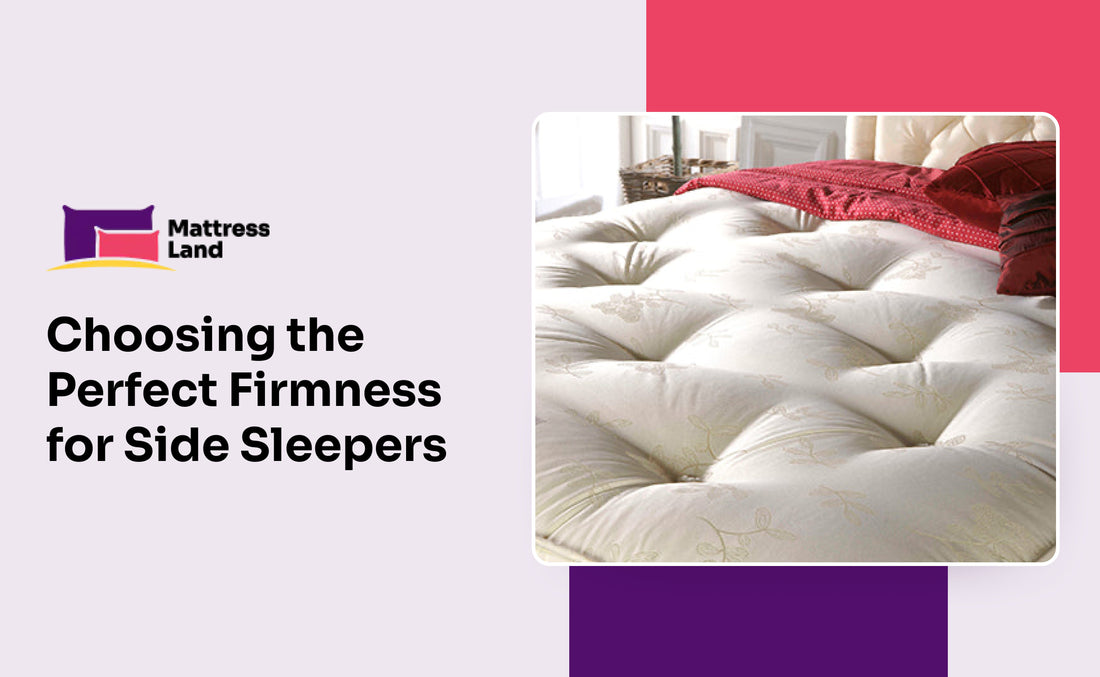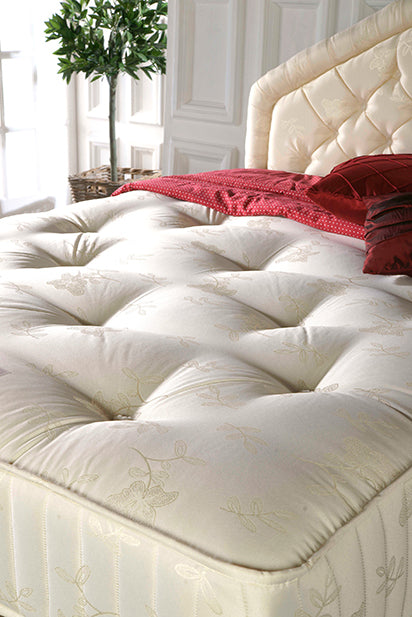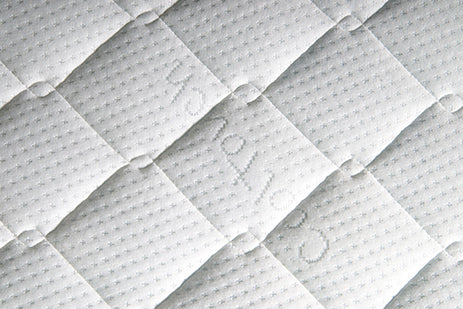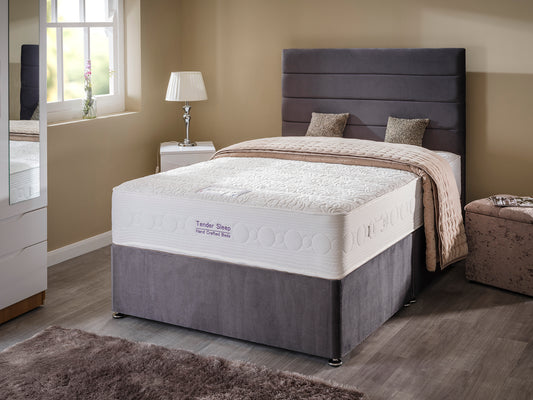Side sleeping is the most popular sleeping position, with about 60-70% of adults preferring it. This position can help with spinal alignment, reduce acid reflux and snoring, and improve circulation. To get these benefits and sleep well, it's important to pick a mattress with the right firmness. Let's look at how side sleepers can choose the best mattress firmness for comfort and support, considering different factors that affect this choice.
Key Takeaways
| Factor | Recommendation |
|---|---|
| Ideal Firmness Range | Medium to Medium-Firm (5-6 on the firmness scale) |
| Body Weight Considerations | Lighter: Softer (3-5), Average: Medium (5-6), Heavier: Firmer (6-8) |
| Pressure Relief | Focus on shoulder and hip comfort |
| Spinal Alignment | Maintain neutral spine position |
| Recommended Mattress Types | Memory Foam, Hybrid, Latex, High-Quality Pocket Spring |
Understanding Mattress Firmness Scales
Mattress firmness is usually measured on a scale from 1 to 10, with 1 being the softest and 10 the firmest. Side sleepers usually do best with medium to medium-firm mattresses, around 5-6 on the scale. This firmness balances support and pressure relief. Remember, firmness can feel different to different people based on their body type. The scale helps you compare mattresses and make good choices.
The firmness scale helps you understand how a mattress will feel and work. A medium-firm mattress, like our Luxury Gold Mattress, offers a good mix of comfort and support for side sleepers. It's soft enough for pressure points but still keeps your spine straight. The Luxury Gold Mattress has layers of dense foam and pocket springs that adjust to your body shape. This is great for side sleepers because it lets your hips and shoulders sink in a bit whilst supporting your waist and lower back.
Factors Influencing Firmness Choice for Side Sleepers
Several things affect which firmness is best for side sleepers. These include body weight, what feels comfortable to you, pressure point relief, and keeping your spine straight. Understanding how these work with different mattress firmnesses helps you make a good choice. Let's break down these factors to help you pick the best mattress for you.
Body Weight
Your weight affects which mattress firmness is best. This is because of how much pressure you put on the mattress. Here's a guide:
- Light sleepers (under 130 lbs): Soft to medium mattress (3-5 on the firmness scale) - These sleepers need a softer mattress to sink in enough.
- Average weight sleepers (130-230 lbs): Medium to medium-firm mattress (5-6 on the firmness scale) - This range works best for most side sleepers.
- Heavy sleepers (over 230 lbs): Medium-firm to firm mattress (6-8 on the firmness scale) - Heavier people need firmer mattresses to keep their spine straight and not sink too much.
Remember, these are general tips. What feels good to you is most important. Things like how much muscle or fat you have can also affect what's comfortable. Our 2000 Pocket Supreme Mattress is medium-firm and works for many body types. Its springs adjust to different weights and shapes, whilst the top layers help with pressure points for side sleepers.
Pressure Point Relief
Side sleepers often feel pressure on their shoulders and hips. A mattress that's too hard can hurt these areas and cause pain or poor circulation. A mattress that's too soft might not support you enough, making your body sink and your spine bend wrong. The best mattress for side sleepers should be soft enough to cushion pressure points but firm enough to keep your body aligned.
Our Flexo Paedic Mattress is made to help with pressure points. Its memory foam layer shapes to your body, spreading out your weight and reducing pressure on key areas. The foam responds to your body heat and pressure, making a custom sleep surface that cradles pressure points. If you like a mix of springs and foam, the Diamond Laytech 2000 Pocket Mattress combines pocket springs with a comfort layer for good pressure relief and support. The springs provide targeted support, whilst the top layers cushion pressure points, making it great for side sleepers who want comfort and responsiveness.
Spinal Alignment
Keeping your spine straight is really important for side sleepers to avoid back pain and sleep well. A mattress that's too soft can make your hips sink too much, whilst one that's too hard might not let your shoulders sink enough. Both can make your spine bend wrong, which can cause discomfort, pain, and poor sleep. The best mattress for side sleepers should let your shoulders and hips sink a little whilst supporting your waist and lower back. This keeps your spine in a neutral position, helping you sleep better and wake up without aches and pains.
To keep your spine straight, side sleepers should look for a mattress that:
- Lets your shoulder sink in a bit, reducing pressure on the joint
- Supports your waist to keep your middle from sinking too much
- Gives enough for your hips to stay in line with the rest of your spine
- Supports your whole body evenly
A medium to medium-firm mattress often works best for keeping side sleepers' spines straight. But remember to think about your body weight and what feels comfortable to you when choosing.
Recommended Mattress Types for Side Sleepers
Whilst firmness is important, the type of mattress also matters for side sleepers' comfort. Different mattress materials and designs offer various benefits for support, pressure relief, and overall comfort. Here are some mattress types that work well for side sleeping, and their benefits:
Memory Foam Mattresses
Memory foam mattresses are great for side sleepers because they shape to your body. They help a lot with pressure on shoulders and hips, which are common sore spots for side sleepers. Our Flexo Paedic Mattress offers a good mix of comfort and support for side sleepers. Memory foam benefits for side sleepers include:
- Great pressure relief and body contouring
- Less movement transfer, good for couples
- Even weight spread to prevent pressure buildup
- Can help keep your spine straight
But some people find regular memory foam gets hot, so look for options with cooling features if you tend to get warm at night.
Hybrid Mattresses
Hybrid mattresses mix the benefits of memory foam and spring mattresses, offering both pressure relief and support. Our Diamond Laytech 2000 Pocket Mattress is a good choice for side sleepers who want a balance of comfort and bounce. Hybrid mattresses give side sleepers:
- The contouring and pressure relief of foam layers
- The support and bounce of pocket springs
- Better airflow and temperature control compared to all-foam mattresses
- A good balance of comfort and support for different body types
Hybrid mattresses can be great for couples with different sleep preferences or for those who like the feel of a traditional spring mattress but need the pressure relief of foam.
Latex Mattresses
Latex mattresses are bouncy and responsive whilst still helping with pressure points. They're also naturally cool, which is good for side sleepers who get hot at night. The benefits of latex mattresses for side sleepers include:
- Natural pressure relief without feeling like you're sinking in like with memory foam
- Very durable and long-lasting
- Hypoallergenic and resistant to dust mites and mould
- Good temperature control for a cool sleep surface
Latex can be great for side sleepers who want pressure relief but don't like the close-hugging feel of memory foam.
Pocket Spring Mattresses
Good quality pocket spring mattresses with a soft top layer can work well for side sleepers. The individual springs provide targeted support, whilst the comfort layer helps with pressure points. Benefits of pocket spring mattresses for side sleepers include:
- Excellent support and weight distribution
- Good airflow for temperature control
- Responsive feel that some sleepers prefer
- Durable and long-lasting, especially with high coil counts
When choosing a pocket spring mattress, look for options with more coils and a comfort layer that cushions pressure points enough.
Additional Comfort Strategies for Side Sleepers
Whilst choosing the right mattress firmness is important, there are other things side sleepers can do to sleep more comfortably. These extra strategies can help with specific issues and make your sleep even better:
- Use a supportive pillow that keeps your head and neck in line with your spine. Look for pillows made for side sleepers, which are often thicker to fill the space between your shoulder and head.
- Put a pillow between your knees to help keep your hips aligned. This can reduce pressure on your lower back and help keep your spine straighter.
- Think about using an adjustable bed base to fine-tune your sleeping position. This can be especially helpful if you have specific health issues or like to read or watch TV in bed.
- Use a mattress topper to adjust the firmness of your current mattress. This can be a cheaper way to change your sleep surface without buying a whole new mattress.
- Try different side-sleeping positions, like the foetal position or the log position, to find what feels most comfortable for you.
- Practice good sleep habits, like going to bed and waking up at the same time each day, having a relaxing bedtime routine, and making your bedroom dark and quiet.
Our Luxury Gold Mattress, along with these strategies, can provide a great sleep setup for side sleepers. Its medium firmness and pressure-relieving features make it a good choice for those seeking comfort and support. The multiple layers of high-quality materials in the Luxury Gold Mattress work together to create a sleep surface that adapts to your body's shape whilst keeping you properly aligned, making it a great foundation for using these extra comfort strategies.
Testing Mattress Firmness: In-Store and At-Home Trials
Choosing the right mattress firmness often takes some trial and error. Whilst online research and recommendations are helpful, trying mattresses yourself is really important when picking one. Here are some detailed tips for testing mattress firmness both in stores and at home:
In-Store Testing Tips
- Lie on the mattress in your usual sleeping position for at least 10-15 minutes. This lets your body settle into the mattress and gives you a better idea of how it feels.
- Pay attention to pressure points and how well the mattress supports your body. Focus on areas like your shoulders, hips, and lower back.
- Try different firmness levels to compare. This can help you understand what you like better.
- Wear comfortable clothes similar to what you might wear to bed.
- If possible, bring your own pillow to make the test more like your usual sleep setup.
- Test the mattress's edge support by sitting on the edge and lying near the edge of the mattress.
- If you sleep with a partner, test the mattress together to check movement transfer and make sure it's comfortable for both of you.
The Importance of Sleep Trials
Many mattress companies, including Mattress Land, offer sleep trials that let you test the mattress at home for a whilst. This is important because it can take several weeks for your body to get used to a new mattress. During this time, pay attention to how you feel when you wake up and if you have any new aches or pains. Keep a sleep diary to track your experiences and any changes in sleep quality. Some key points about sleep trials:
- Most sleep trials last between 30 to 100 nights, with some companies offering even longer periods.
- Use this time to check not just comfort, but also things like temperature control and any allergic reactions.
- Don't make up your mind in the first few days; give your body time to adjust to the new sleep surface.
- If the mattress isn't working for you, don't hesitate to use the return or exchange policy.
Breaking in Your New Mattress
Remember that most mattresses have a break-in period. It's normal for a mattress to feel different in the first few weeks as the materials adjust to your body. Give yourself time to get used to the new mattress before making a final decision. During this break-in period:
- Rotate the mattress regularly (if the manufacturer recommends it) to ensure even wear.
- Use the mattress consistently, even if it feels unfamiliar at first.
- Be patient and wait at least 30 days before deciding if the mattress is right for you.
- If you're uncomfortable, try adjusting your pillow or sleeping position before deciding the mattress is the problem.
By following these testing strategies and giving yourself enough time to adjust, you're more likely to find the perfect mattress firmness for your side-sleeping needs.
Addressing Common Side Sleeper Concerns
Side sleepers often have specific worries when choosing a mattress. Understanding these issues and how to address them can help you make a better decision and improve your overall sleep quality. Here are some common issues and how to address them:
Shoulder Pain
If you're having shoulder pain, your mattress might be too firm. Look for a mattress with a softer top layer, like our Luxury Gold Mattress, which offers great pressure relief for shoulders. To address shoulder pain:
- Choose a mattress with a soft top layer that lets your shoulder sink in a bit
- Consider a mattress with zoned support that's softer around the shoulders
- Use a pillow that keeps your head and neck in line with your spine to reduce shoulder strain
- Try sleeping with your arm slightly forward instead of directly under your body
Hip Discomfort
Hip pain can be caused by a mattress that's either too firm or too soft. A medium to medium-firm mattress often provides the right balance of support and cushioning for the hips. To help with hip discomfort:
- Look for a mattress with targeted support in the hip area
- Consider using a mattress topper for extra cushioning if your current mattress is too firm
- Place a thin pillow between your knees to improve hip alignment
- Make sure your mattress is supportive enough to prevent your hips from sinking too deeply
Partner Disturbance
If you sleep with a partner, consider a mattress with good motion isolation. Memory foam and pocket spring mattresses are excellent choices for minimising movement transfer. To reduce partner disturbance:
- Choose a mattress with individually wrapped coils or memory foam for better motion isolation
- Consider a larger mattress size to give each person more space
- Use a split king or two separate mattresses if you have very different firmness preferences
- Look for mattresses with reinforced edge support to prevent rolling off when sleeping near the edge
Temperature Regulation
Side sleepers often sleep hot because more of their body is in contact with the mattress. Look for mattresses with cooling technologies or breathable materials to help control temperature. To improve temperature regulation:
- Choose mattresses with gel-infused foam or phase-change materials for better heat dissipation
- Consider latex or hybrid mattresses, which tend to sleep cooler than traditional memory foam
- Use breathable, moisture-wicking bedding materials
- Keep your bedroom at a cool, comfortable temperature (around 60-67°F or 15-19°C)
Conclusion: Making the Right Choice for Your Sleep Health
Choosing the right mattress firmness as a side sleeper is really important for how well you sleep and your overall health. It's a decision that needs careful thought about various factors, including your body type, what you like, and your specific sleep needs. At Mattress Land, we offer many mattresses suitable for side sleepers, including our popular Cashmere Pocket Mattress. Remember to think about your body type, what feels comfortable to you, and the need for pressure relief and keeping your spine straight when making your choice.
When picking a mattress, keep in mind that what works for one person might not be ideal for another. Your unique body shape, sleep habits, and health conditions all play a role in determining the best mattress for you. Don't hesitate to use our in-store testing options and sleep trials to find the perfect mattress for your needs. These opportunities let you experience different mattress types and firmness levels firsthand, helping you make a more informed decision.
Investing in a good mattress that suits your side-sleeping needs can really improve your overall well-being. A good night's sleep helps with better physical health, clearer thinking, and more productivity during the day. By choosing a mattress that provides the right balance of support and comfort, you're not just buying a piece of furniture – you're investing in your health and quality of life.
Your ideal mattress is out there, and with the right information and guidance, you'll be on your way to better, more comfortable sleep. Visit our side sleeper mattress collection to explore options made specifically for side sleepers. Our expert staff is always available to answer your questions and help you find the perfect mattress to suit your individual needs. Remember, a good night's sleep is priceless, and the right mattress is the foundation for achieving it.
Frequently Asked Questions
Q: How do I know if my mattress is too firm or too soft for side sleeping?
A: If you wake up with shoulder or hip pain, your mattress might be too firm. If you feel like you're sinking too deeply and have lower back pain, it might be too soft. The ideal mattress should let your shoulders and hips sink slightly whilst supporting your waist and lower back. Pay attention to how you feel when you wake up and throughout the day. If you often feel uncomfortable or don't sleep well, it might mean your mattress isn't providing the right support for side sleeping.
Q: Can a mattress topper help adjust the firmness for side sleeping?
A: Yes, a mattress topper can be a good way to adjust firmness. A soft topper can add cushioning to a firm mattress, whilst a firmer topper can provide more support to a soft mattress. Mattress toppers come in different materials and thicknesses, letting you fine-tune your sleep surface. However, remember that a topper is a temporary solution and might not work as well as choosing the right mattress in the long run.
Q: How often should I replace my mattress as a side sleeper?
A: Generally, you should replace mattresses every 7-10 years. However, if you notice ongoing discomfort, visible sagging, or your sleep quality gets worse, it might be time to replace your mattress sooner. Side sleepers might need to replace their mattresses more often because of the concentrated pressure on certain areas of the mattress. Regularly rotating your mattress and taking good care of it can help it last longer.
Q: Are memory foam mattresses good for side sleepers?
A: Yes, memory foam mattresses are often great for side sleepers because they shape to your body and relieve pressure. They adapt to your body shape, providing support where needed and reducing pressure on shoulders and hips. However, some people find memory foam gets hot, so look for options with cooling technologies if you tend to sleep warm. Also, memory foam mattresses can have different levels of firmness, so it's important to choose one that provides the right balance of support and comfort for your body type and preferences.
Q: Can side sleeping on the wrong mattress cause back pain?
A: Yes, sleeping on a mattress that's too firm or too soft can lead to back pain for side sleepers. The right mattress should keep your spine straight to prevent back pain and discomfort. If your mattress doesn't provide enough support or pressure relief, it can cause your spine to bend wrong, leading to muscle tension and pain. It's important to choose a mattress that lets your hips and shoulders sink slightly whilst supporting your waist and lower back, keeping your spine in a neutral position all night.
Body Weight
Choose firmness based on your weight: Soft for light, Medium for average, Firm for heavy
Mattress Type
Memory foam, hybrid, or latex mattresses are ideal for side sleepers
Firmness Scale
Aim for 5-6 on the 1-10 firmness scale for optimal side sleeping comfort
Pressure Relief
Look for mattresses with good pressure relief for shoulders and hips










